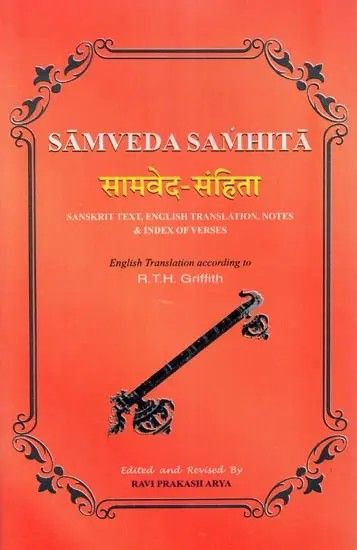Samaveda English
Samaveda, one of the four Vedas, holds a significant place in the ancient Indian scriptures. It is a treasure trove of melodious chants, profound wisdom, and spiritual insights. The Samaveda, with its unique musical notation and poetic style, has captivated generations with its divine essence. In this article, we will delve into the historical background, structure, significance, and contemporary relevance of Samaveda, unraveling the mystical realms of this ancient scripture.
Table of Contents

Disclaimer / Notice: The preview images presented are only for reference purposes and are the property of the PDF's actual / respective owners / copyright holders. We do not claim ownership of these photographs. Please report any problems with the PDF or photos used.
Historical Background of Samaveda
Samaveda, meaning “the Veda of chants,” has its roots deeply embedded in the rich tapestry of Indian history and culture. It is believed to have originated around 1500 BCE, during the Vedic period. The Vedic sages, inspired by divine revelations, carefully preserved the sacred knowledge within the verses of Samaveda. The hymns and chants found in Samaveda were passed down through generations orally, with utmost precision and purity.
Structure of Samveda
The Samaveda is divided into four main sections, each serving a unique purpose in the Vedic tradition: Samhita, Brahmanas, Aranyakas, and Upanishads.
The Samhita section consists of hymns and chants that are recited during rituals and ceremonies. These chants are believed to have the power to invoke divine blessings and establish a profound connection with the spiritual realm.
The Brahmanas, the next section, provide detailed explanations and instructions regarding the proper performance of rituals and sacrifices. They serve as a guide for priests and scholars in understanding the complex symbolism and significance behind the rituals associated with Samaveda.
The Aranyakas, known as the “forest texts,” contain philosophical and spiritual teachings. They were primarily studied and contemplated upon by those seeking a deeper understanding of the spiritual aspects of life.
Lastly, the Upanishads, which form the philosophical essence of Samaveda, explore profound truths about the nature of existence, self-realization, and the ultimate reality. These teachings have had a profound impact on Hindu philosophy and spirituality.
Significance of Samaveda
Samaveda holds immense importance in the Vedic tradition and Indian culture as a whole. It is regarded as the embodiment of divine knowledge and wisdom. The chants and hymns of Samaveda are believed to have the power to purify the mind, uplift the spirit, and invoke spiritual growth. The Vedic sages recognized the profound connection between sound, vibration, and consciousness, and the chants of Samaveda are considered a gateway to higher states of consciousness.
Chants and Melodies in Samaveda
One of the distinguishing features of Samaveda is its unique system of musical notation and melodic patterns. The chants, known as Sama chants, are not merely recited but are sung in a specific musical style. The verses of Samaveda are carefully arranged with precise instructions on the pitch, rhythm, and intonation.
The melodies of Samaveda are captivating and evoke a sense of deep spiritual resonance. The sages understood the power of music to touch the heart and elevate the soul. The rhythmic patterns and intricate melodies of Samavedic chants have a profound impact on the listener, creating an atmosphere of tranquility, devotion, and inner harmony.
Rituals and Ceremonies Associated with Samaveda
Samaveda plays a central role in various rituals and ceremonies in the Vedic tradition. The chants are recited during sacred ceremonies like Yajnas (fire rituals), Soma sacrifices, and other religious observances. The precise recitation of Samavedic verses, accompanied by rhythmic beats and enchanting melodies, helps create a sacred and auspicious environment.
These rituals not only serve as a means of connecting with the divine but also reinforce the cultural and social fabric of the community. They foster a sense of unity, devotion, and reverence among the participants, creating a harmonious bond between individuals and the cosmos.
Influence of Samaveda on Indian Classical Music
The influence of Samaveda extends beyond the realm of religious rituals. It has played a pivotal role in shaping the rich heritage of Indian classical music. The melodic patterns, ragas (musical scales), and intricate rhythms found in Indian classical music have their roots in the chants and melodies of Samaveda.
The ancient treatises on music, such as the Natya Shastra and the Sangeet Ratnakara, draw inspiration from the principles laid down in Samaveda. The aesthetics, improvisation techniques, and the spiritual essence of Indian classical music find their source in the profound musical heritage of Samaveda.

Preservation and Transmission of Samavedic Texts
Over the centuries, the preservation and transmission of Samavedic texts have been of utmost importance. The oral tradition of reciting the verses with meticulous accuracy ensured the continuity and authenticity of the Samaveda. The tradition of Guru-Shishya parampara (teacher-disciple lineage) played a vital role in passing down the knowledge from one generation to the next.
In later centuries, the texts of Samaveda were meticulously documented to safeguard the sacred wisdom. Sanskrit scholars and Vedic experts devoted their lives to the preservation and meticulous study of the Samavedic texts. Today, these ancient texts continue to be preserved in various libraries, universities, and cultural institutions, allowing future generations to access this timeless wisdom.
Contemporary Relevance and Practices of Samaveda
Despite being thousands of years old, Samaveda remains relevant and continues to inspire people in the modern world. Many individuals and spiritual seekers are drawn to the profound teachings and transformative power of Samaveda.
In the contemporary context, the chanting of Samavedic verses is not limited to religious ceremonies alone. People engage in personal recitation and group chanting as a means of spiritual practice and self-discovery. The soothing and meditative qualities of Samavedic chants help individuals find solace, inner peace, and a deeper connection with their inner selves.
Samaveda in the Modern World
In the modern world, the wisdom encapsulated in Samaveda has found its way into various spheres of life. The principles of sound and vibration are being explored in fields like sound therapy, meditation, and holistic healing practices. The therapeutic effects of Samavedic chants are being recognized and utilized to promote physical
health and emotional well-being.
The rhythmic patterns and melodic structure of Samavedic chants have a calming and harmonizing effect on the mind and body.
Moreover, the philosophical teachings embedded within Samaveda offer profound insights into the nature of existence, human consciousness, and the interconnectedness of all beings. These teachings serve as a guiding light for individuals seeking meaning, purpose, and spiritual growth in their lives.
Samaveda and Spiritual Well-being
Samaveda holds a special place in the realm of spiritual well-being. The chants and melodies of Samaveda have the power to create a sacred space within oneself, allowing for deep introspection and connection with the divine. The repetition of sacred sounds and mantras helps quiet the mind, release stress, and cultivate inner peace.
By engaging with the verses of Samaveda, individuals can embark on a spiritual journey of self-discovery, self-realization, and transcendence. The profound teachings contained within Samaveda provide insights into the nature of the self, the ultimate reality, and the path to spiritual liberation.
Impact of Samaveda on Personal Growth and Meditation
Samaveda offers a pathway to personal growth and self-transformation. The regular practice of chanting Samavedic verses can enhance focus, concentration, and mindfulness. It helps individuals develop a deep connection with their inner selves and tap into their inherent wisdom and intuition.
Through the rhythmic recitation of Samavedic chants, individuals can enter a meditative state, experiencing a sense of unity with the divine and the universe. This meditative practice fosters clarity, inner calm, and a heightened sense of awareness, leading to personal growth and spiritual evolution.
Understanding the Chants of Samaveda
The chants of Samaveda are composed in Vedic Sanskrit, a sacred language known for its precision and vibrational power. The verses are filled with symbolism, metaphors, and profound philosophical concepts. Understanding the meaning and essence of these chants requires a deep study and contemplation of the Vedic texts.
By immersing oneself in the study of Samaveda, one can unravel the hidden layers of wisdom contained within the verses. The chants offer insights into cosmic principles, ethical values, and the interconnectedness of all beings. Exploring the depths of Samaveda opens doors to a deeper understanding of the human experience and our place in the universe.
Exploring the Philosophical Concepts in Samaveda
Samaveda delves into profound philosophical concepts that have shaped the course of Indian philosophy and spirituality. The Upanishads, in particular, expound upon the nature of the self (Atman), the ultimate reality (Brahman), and the path to spiritual liberation (Moksha).
The teachings of Samaveda emphasize the inherent divinity within every individual and the interconnectedness of all beings. They invite us to cultivate virtues such as compassion, truthfulness, and self-discipline. The philosophical concepts found in Samaveda inspire individuals to lead a purposeful life, aligned with higher ideals and spiritual values.
Samaveda English PDF
| Book Name | The Samaveda Samhita |
| Translator | Rev. J. Stevenson |
| Original Language | Sanskrit |
FAQs
1. Is the Samveda only related to music?
No, the Samveda is not solely related to music. While it is known as the “Veda of melodies,” it encompasses much more. The Samveda contains hymns that cover various themes, including nature, spirituality, and divine worship. Its verses provide insights into Hindu rituals, philosophy, and the cultural fabric of ancient India.
2. Can anyone learn and recite the hymns of the Samveda?
Traditionally, the recitation of Samveda hymns was limited to trained priests and individuals who had undergone rigorous study and initiation. However, in modern times, there are resources available for anyone interested in learning and understanding the Samveda. It is essential to approach the study with respect and a willingness to delve into the profound meanings behind the chants.
3. How does the Samveda contribute to Indian classical music?
The Samveda’s rhythmic patterns, melodic structures, and poetic expressions have greatly influenced the development of Indian classical music. The concepts of ragas (melodic modes) and talas (rhythmic patterns) find their roots in the Samveda’s musical heritage. Many compositions in classical music draw inspiration from the Samveda’s melodic contours and evoke the essence of its timeless verses.
4. Are there any modern adaptations of the Samveda hymns?
Yes, there have been modern adaptations of the Samveda hymns in various musical genres. Artists and composers have incorporated elements of the Samveda’s melodies and verses into contemporary music compositions. These adaptations aim to bring the ancient wisdom of the Samveda to a wider audience while maintaining reverence for its cultural and spiritual significance.
5. How can one access and appreciate the Samveda today?
To access and appreciate the Samveda, individuals can explore translations, commentaries, and interpretations of its hymns. Several scholarly works and online resources provide insights into the Samveda’s content, meaning, and cultural significance. Additionally, attending traditional Hindu rituals and music performances inspired by the Samveda can offer a firsthand experience of its profound impact.
6. Is Samaveda only relevant for those following the Vedic tradition?
While Samaveda holds significant importance in the Vedic tradition, its teachings and practices are not limited to a particular religious or cultural group. The wisdom of Samaveda transcends boundaries and can be embraced by individuals from diverse backgrounds.
7. How can I incorporate Samavedic chants into my daily life?
You can incorporate Samavedic chants into your daily life by setting aside dedicated time for chanting and meditation. Start with a few verses or mantras from Samaveda and gradually expand your repertoire. You can also join group chanting sessions or utilize recorded chants for guidance.
8. Are there any scientific studies on the effects of Samavedic chants?
While scientific research on Samavedic chants is limited, studies have shown the positive effects of chanting and sound vibrations on stress reduction, relaxation, and mental well-being. The transformative power of Samavedic chants has been experienced by countless individuals throughout history.
9. Can listening to Samavedic chants have an impact on emotional well-being?
Yes, listening to Samavedic chants can have a profound impact on emotional well-being. The melodic patterns and rhythmic intonations create a calming effect, promoting relaxation, peace, and emotional balance.



